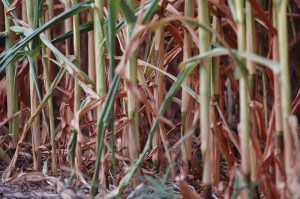Mahaska County Drought Intensifies
Oskaloosa, Iowa – Mahaska County, along with Marion, Monroe and Wapello Counties are all under an Excessive Heat Warning until 3 pm on Wednesday.
This has been “normal” lately in South-central Iowa as the lack of rain coupled with excessive heat has one of the worst droughts on record only intensifying. The National Weather Service in Des Moines said of the heat, “The first three weeks of July ranked as the second-warmest on record in Des Moines, only behind the infamously hot July of 1936.”
The heat isn’t the only problem, the lack of rain has farmers talking about the droughts of 1988 and 1977. Making this year especially hard is the one/two punch of both the lack of moisture and the heat.
“Des Moines summer precipitation through today (July 21) has been 2.45 inches. Assuming we stay dry for the remainder of the day that would rank this summer as the 5th driest on record to date. This would be the driest since 1927, even surpassing the Dust Bowl years,” was the comment from the National Weather Service about the current lack of rainfall.
The USDA Drought Monitor recently updated Mahaska County from being in a Moderate Drought to Severe Drought conditions. Current forecasts predict the drought to continue at least through the end of October.
Most farmers carry crop insurance to help protect them against the losses incurred by a drought. But Vicki Van Donselaar, a local farmer, said that having a crop destroyed by drought is tough, even with insurance, because the reason a farmer works the field is seeing the satisfaction of a good harvest at the end of the year.
Van Donselaar said she wouldn’t be surprised to see combines in the field next month if the current conditions continue.
According to the USDA, soil moisture continues to decline, “Topsoil moisture levels declined to 58 percent very short, 34 percent short, 8 percent adequate, and 0 percent surplus. South Central Iowa is the driest with 99 percent of the topsoil moisture rated short to very short. Subsoil moisture dropped to 48 percent very short, 41 percent short, 11 percent adequate, and 0 percent surplus.”
Soybeans are currently doing better than corn with 76% being rated as Fair/Good. Only 4% were rated as Excellent, while 5% were rated as poor. Corn is rated as 69% Fair/Good with 4% being in Excellent condition. The number of corn crops in poor conditions is currently rated at 8%.
Hay condition is rated 15 percent very poor, 24 percent poor, 40 percent fair, 20 percent good, and 1 percent excellent. Less than ten percent of Iowa’s pasture and range land is rated good to excellent. Pasture and range condition rated 26 percent very poor, 36 percent poor, 29 percent fair, 8 percent good, and 1 percent excellent. The heat continues to cause stress for livestock with some deaths being reported.
Late last week, Governor Branstad’s Office sent out a press release encouraging farmers to utilize Iowa’s ditches. “Gov. Branstad today encouraged farmers to harvest grass in the state highway right of way as a way to help combat this summer’s drought.”
“Under the hot and dry conditions that the state is and has been experiencing, farmers are searching for alternative ways to feed their livestock. Harvesting grass along the side of state roads is an efficient and economical means for farmers to maintain their livestock levels,” said Branstad.
Farmers are allowed to legally mow and bale grass on highway right of ways only during certain periods of the year, as established by the Iowa Department of Transportation.
Persons interested must have a permit, granted by the Iowa DOT, before mowing. The permit form can be found here. All work should be performed between 30 minutes after sunrise and 30 minutes before sunset.
















